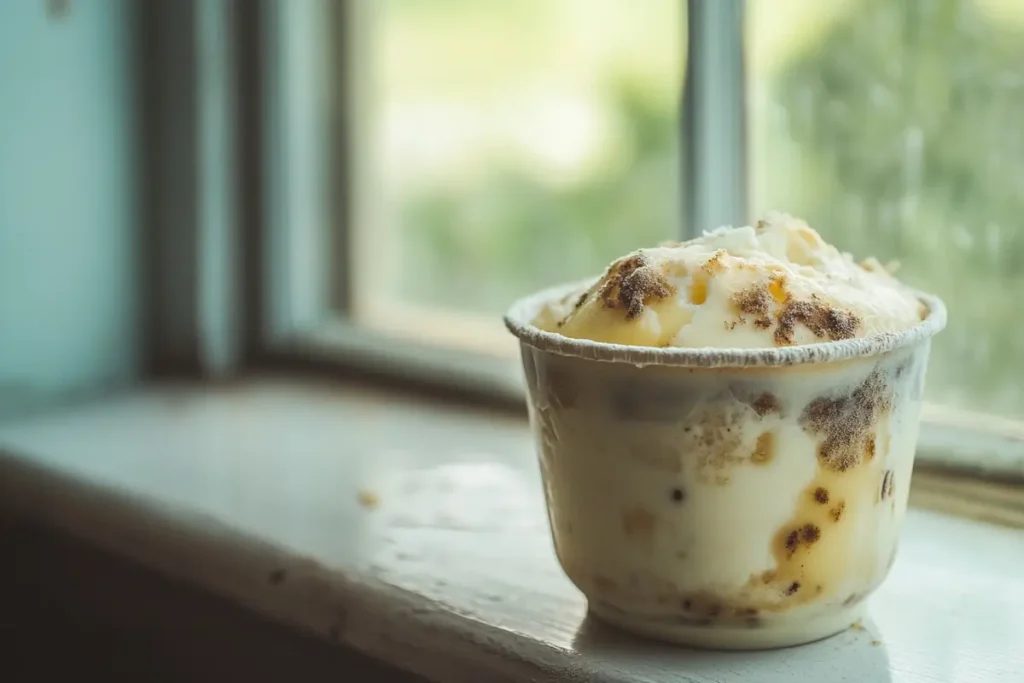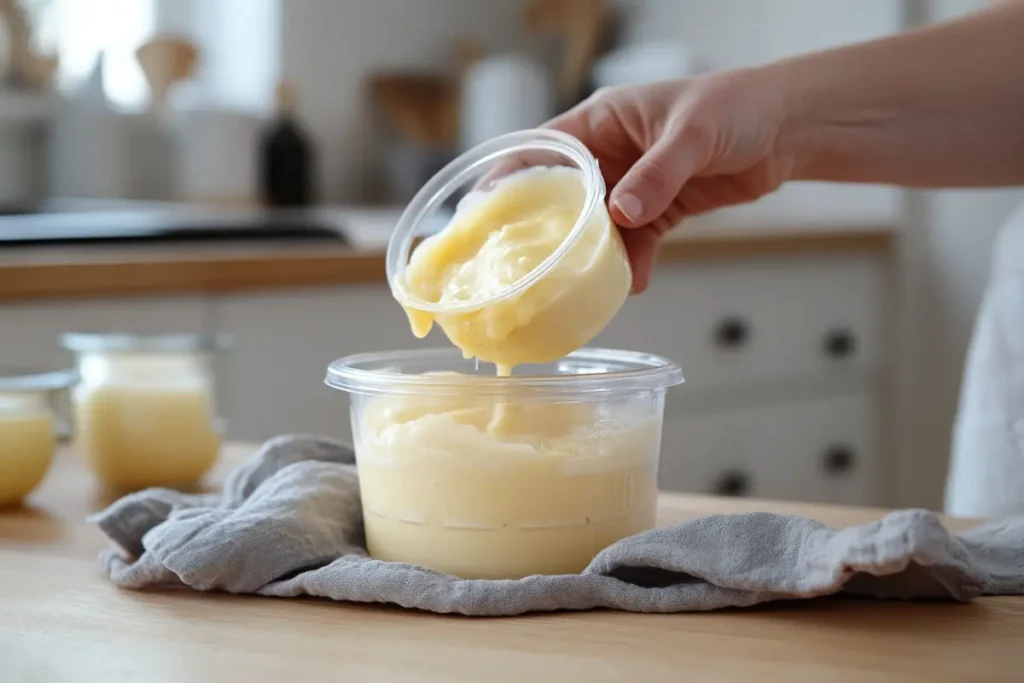Understanding Pre-Made Pudding
Pre-made pudding is a convenient, ready-to-eat dessert that comes in sealed cups, pouches, or cartons.Manufacturers typically combine milk, sugar, starch, and flavorings, then add preservatives to extend the pudding’s shelf life. Available in various flavors like chocolate, vanilla, and butterscotch, this quick snack is a household staple.
Unlike homemade pudding, store-bought versions undergo commercial processing, which makes them last much longer. However, once you break the seal, the pudding becomes just as prone to spoilage as any other food.
Common Types of Pre-Made Pudding
Nutritional Facts for Pre-Made Pudding (Per 100g Serving)
| Nutrient | Amount (per 100g) |
|---|---|
| Calories | 120 kcal |
| Protein | 2g |
| Total Fat | 3.5g |
| Saturated Fat | 2g |
| Carbohydrates | 20g |
| Sugars | 15g |
| Fiber | 0.5g |
| Sodium | 120mg |
Pre-made pudding can vary in ingredients and packaging, which also affects its longevity. Here’s a breakdown of the most common types:
- Dairy-Based Puddings: These contain milk or cream and are more likely to spoil quickly once opened.
- Non-Dairy Puddings: Often made with almond, soy, or oat milk, these can last a bit longer but still require careful handling.
- Shelf-Stable Pudding Cups: These are designed to last months when unopened and stored properly but should be refrigerated after opening.
- Refrigerated Pudding: These types need to be stored in the fridge from the moment you purchase them.
Each type has its unique storage needs, so it’s important to know what you’re working with when determining whether it’s safe to eat.
Ingredients and Preservation Methods
What makes pudding last longer? Ingredients and preservation techniques play a crucial role:
- Preservatives: Most store-bought puddings contain preservatives like potassium sorbate or citric acid, which slow bacterial growth.
- Thickening Agents: Cornstarch or gelatin is used to maintain the pudding’s creamy texture.
- Vacuum-Sealing: The air-tight packaging prevents exposure to oxygen, which slows down the spoilage process.
However, once the packaging is compromised, the preservatives can only do so much. Understanding these ingredients can help you store pudding more effectively and prevent unnecessary waste.
Shelf Life of Pre-Made Pudding
Understanding the shelf life of pre-made pudding is crucial for avoiding an unpleasant surprise when you grab a snack. Whether the pudding is unopened, opened, or stored incorrectly, each situation impacts how long it stays fresh. Let’s break it down!
Unopened Pre-Made Pudding Shelf Life
Pre-made pudding is typically designed to last for months when left unopened, thanks to its preservatives and sealed packaging.
- Shelf-Stable Pudding Cups: These can last 3 to 6 months past the best-before date when stored in a cool, dry pantry.
- Refrigerated Pudding: Needs to stay in the fridge at all times and usually lasts 1 to 2 weeks beyond the printed date if unopened.
However, best-before dates are not absolute expiration dates—they indicate peak quality, not safety. So, while the texture or taste may change after that time, it doesn’t always mean the pudding is spoiled.
Pro Tip: Always check for signs of spoilage before diving in, even if the date suggests it’s still fine!
Opened Pre-Made Pudding Shelf Life
Once you break the seal, the clock starts ticking!
- Dairy-Based Pudding: Should be consumed within 5 to 7 days after opening if stored in the refrigerator.
- Non-Dairy Pudding: Typically lasts 7 to 10 days after opening.
- Homemade-Style or Fresh Pudding: Shorter lifespan, around 3 to 4 days.
To avoid any doubts, write the date on the lid when you open it. This quick step helps you keep track of freshness at a glance!
Factors Influencing Shelf Life
Several factors can impact how long your pudding stays safe and tasty:
- Storage Temperature: A consistent cold environment (around 4°C or 40°F) preserves pudding better. Any temperature spikes can speed up spoilage.
- Packaging Integrity: If the seal is punctured or loose, oxygen enters and accelerates bacterial growth.
- Ingredients: Dairy-based puddings spoil faster due to their perishable components, while non-dairy varieties tend to last longer.
Even minor mishandling—like leaving pudding out at room temperature for too long—can drastically shorten its lifespan.
Identifying Spoilage in Pre-Made Pudding
Even if your pudding looks okay at first glance, there may be subtle clues that it’s no longer safe to eat. Spoiled pudding can be a breeding ground for bacteria, so it’s important to know what to watch out for before taking that first bite. Let’s go over the telltale signs!
Visual Signs of Spoilage

Your eyes are your first line of defense when checking pre-made pudding for spoilage. Here’s what to look for:
- Mold Growth: If you notice any green, white, or fuzzy patches forming on the surface, toss it immediately—there’s no salvaging moldy pudding.
- Discoloration: Pudding that was once creamy beige or chocolate brown but is now grayish or has strange streaks is a warning sign.
- Watery Layer: Some separation of liquid is normal, especially in non-dairy puddings. But excessive pooling of liquid combined with a slimy surface can indicate bacterial activity.
If anything about the appearance seems off, it’s better to be safe than sorry.
Changes in Texture and Consistency
Pudding should have a smooth, creamy consistency, especially for those who enjoy protein puddings as part of their daily diet. A change in texture can be an early sign of spoilage:
- Clumps or Lumps: If the pudding feels grainy or clumpy when you stir it, it’s likely gone bad.
- Excessive Thickness or Sliminess: Spoiled pudding may become unusually thick, almost like gelatin, or develop an unpleasantly slimy texture.
These changes often happen due to bacterial growth breaking down the proteins and sugars in the pudding.
Off-Putting Smells and Tastes
Smell and taste can provide final confirmation of spoilage:
- Sour or Fermented Smell: A fresh pudding has a mild, sweet aroma. If it smells tangy, sour, or has a chemical-like scent, don’t eat it.
- Bitter or Rancid Taste: If you take a bite and notice any bitterness, sharpness, or metallic aftertaste, spit it out and discard the pudding immediately.
It’s not worth the risk—spoiled pudding can cause foodborne illnesses like stomach cramps, nausea, or worse.
Proper Storage Practices for Pre-Made Pudding
To make your pudding last as long as possible—and avoid unpleasant surprises—it’s important to store it correctly. The right storage methods can significantly extend the shelf life and preserve the texture and flavor of your sweet treat. Here’s how to keep your pudding fresh and delicious!
Ideal Storage Conditions

Storage conditions play a crucial role in maintaining pudding’s freshness. Here’s how you can get it right:
- Unopened Shelf-Stable Pudding: Store in a cool, dry pantry away from direct sunlight and heat.
- Refrigerated Pudding (Unopened or Opened): Keep it in the coldest section of your fridge (not the door) where the temperature stays consistent.
- Temperature: The ideal storage temperature is 4°C (40°F) or lower to prevent bacterial growth, but always check how long protein pudding lasts in the fridge for reference.
Keep pudding away from heat sources and places with fluctuating temperatures, as these conditions can shorten its lifespan.
Impact of Temperature on Shelf Life
Temperature mishandling is one of the biggest causes of pudding spoilage:
- Left Out at Room Temperature: Dairy-based puddings can spoil within 2 hours if left unrefrigerated.
- Hot, Humid Conditions: Heat accelerates spoilage by encouraging bacteria to grow faster, making the pudding unsafe to eat.
- Frozen Storage: While it’s possible to freeze pudding, this can alter the creamy texture, making it more gelatinous or grainy when thawed.
If you must freeze pudding, store it in an airtight container and consume it within 1 to 2 months. However, freezing works better for homemade or non-dairy puddings.
Importance of Airtight Containers

Once you’ve opened a pudding cup, proper sealing is key to keeping it fresh:
- Airtight Containers: Transfer the pudding to a tightly sealed glass or plastic container if you’re not finishing it in one go. This prevents air from getting in and bacteria from growing.
- Plastic Wrap Trick: If you’re using the original cup, place a piece of plastic wrap directly on the surface of the pudding to minimize air contact.
A proper seal also keeps the pudding from absorbing odors from other foods in the fridge, which can affect its taste.
Frequently Asked Questions About Does Pre-Made Pudding Go Bad
When it comes to pre-made pudding, many people have questions about expiration dates, storage, and safety. Here are answers to some of the most common queries to clear up any lingering doubts.
Can you eat pre-made pudding after the expiration date?
The short answer is: it depends. If the pudding is unopened and stored properly, shelf-stable versions can remain good for several weeks after the “best-before” date. However, the flavor or texture might degrade slightly. Refrigerated pudding is more sensitive, so it’s best to stick close to the printed date to ensure it’s safe. Always check for spoilage signs, such as mold or a sour smell, before eating.
How long does homemade pudding last compared to store-bought?
Homemade pudding typically lasts 3 to 4 days when stored in an airtight container in the fridge.Unlike store-bought versions, homemade pudding lacks preservatives, similar to the natural ingredients used in creamy desserts like crème brûlée. making it more prone to spoilage. You can keep store-bought pudding, especially the shelf-stable variety, unopened for weeks or even months, but you should eat it within a week after opening.
Is it safe to leave pre-made pudding unrefrigerated?
No, dairy-based pre-made pudding should not be left at room temperature for more than 2 hours. If it’s a hot day, spoilage can happen even faster. Shelf-stable pudding can sit in a pantry until opened but should be moved to the fridge immediately afterward. Leaving it out can encourage the rapid growth of harmful bacteria, making the pudding unsafe to eat.
Can you freeze pre-made pudding to extend its shelf life?
Yes, you can freeze pre-made pudding, but experts don’t always recommend it unless you’re okay with a change in texture. Freezing can make the pudding separate or become grainy. If you choose to freeze it, use a freezer-safe, airtight container and consume it within 1 to 2 months. Thaw it slowly in the fridge and stir well before eating to restore some of the consistency.
Conclusion Of Does Pre-Made Pudding Go Bad
Pre-made pudding is a delicious and convenient treat that offers the perfect balance of sweetness and creamy texture. However, just like any perishable item, it can go bad if it’s not stored and handled properly. The key to enjoying every last spoonful without worry is understanding how to identify spoilage, follow proper storage practices, and know when it’s time to toss it out.
Whether you’re dealing with shelf-stable or refrigerated pudding, it’s important to check the packaging for dates and handling instructions. Shelf-stable pudding can last for months in your pantry if kept sealed and away from heat, but once you open it, it belongs in the fridge. Refrigerated pudding, on the other hand, requires consistent cold storage from the get-go. In both cases, once opened, the pudding should ideally be eaten within a week.
Knowing the signs of spoilage can also save you from unpleasant surprises. Always inspect your pudding for any unusual changes—like mold, discoloration, or excessive liquid separation. Spoiled pudding often has a sour or chemical-like smell and may taste bitter or “off.” If anything seems suspicious, it’s better to be safe than sorry.
For more in-depth food safety tips, trusted sources such as the USDA Food Safety page or expert guides on preserving desserts can be helpful. And whenever you’re uncertain about your pudding’s freshness, remember the golden rule: when in doubt, throw it out! Your health is far more important than saving a questionable snack.
By following these simple tips, you can continue to enjoy your pre-made pudding worry-free and savor its creamy goodness every time!

